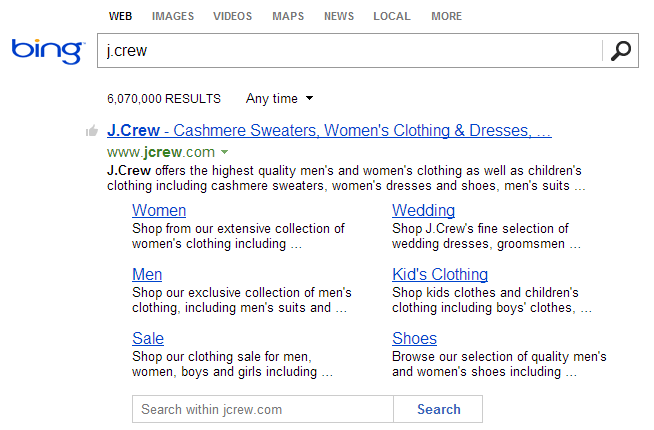Search is a funny thing. Right when the industry starts to get the hang of the processes that go into search engine optimization and quality control, companies like Google and Bing transition mid-step and head down another avenue. This can be pretty annoying for businesses trying to reach the top of results with SEO and content marketing, but every evolution in search is meant for the end user, and in Bing’s latest search tests, it’s clear the company has to commit to getting the best information toward the top of SERPs.
In a recent blog post, Bing’s Research and Development team’s Partner Architect Dr. Ronny Kohavi exposes the truths behind clickthrough rates in Bing SERPs. Kohavi notes that more than 50 percent of Bing users click on the first result in search results, and when the first option includes “deep links,” the CTR increases to more than 75 percent.
 Deep links, as Kohavi referred to them, appear in groupings below a certain result. For example, when a user searches the term “J.Crew,” he or she sees the homepage as the first result in Bing, and below the link, are results for Women, Men, Shop and several other pages hosted on J.Crew’s main site.
Deep links, as Kohavi referred to them, appear in groupings below a certain result. For example, when a user searches the term “J.Crew,” he or she sees the homepage as the first result in Bing, and below the link, are results for Women, Men, Shop and several other pages hosted on J.Crew’s main site.
The problem with Bing’s recently released metrics is that the engine may put smaller brands at clear disadvantages. If web searchers on Bing so regularly favor the first option and all other options get few clicks, the company’s algorithms and systems benefit brands with bigger SEO content budgets or bigger companies likely to get deep links.The blog post also explains what website owners can expect from search if their pages don’t rank No. 1 for certain queries. The search engine shows a 4 to 6 percent CTR for the third result, between 2 and 3 percent for the fourth option and fewer than 1 percent for the eighth link. The graph included in the post did not show the CTR for No. 2 search result.
Everyone knows that ranking higher in SERPs produces more organic traffic back to branded websites, and Bing’s audience is quick to select the first option presented to them online. What’s the key to Bing SEO? As Duane Forrester has said, “Never lose sight of the fact that all SEO ranking signals revolve around content of some kind.”
Smaller businesses that can’t outrank big brands can still increase website conversions via Microsoft’s search engine by publishing high-quality web content. When users don’t find what they’re looking for in a Bing result, and they click the back button in their browsers, Bing provides them with up to 18 alternative options in search. This could help smaller brands with better editorial prowess clean up the missed opportunities left in search by over-optimized corporate sites.



